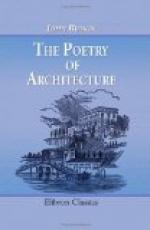[Illustration: FIG. 8. Coniston Hall, from the Lake near Brantwood (1837).]
70. Of English chimneys adapted for buildings of a more elevated character, we can adduce no good examples. The old red brick mass, which we see in some of our venerable manor-houses, has a great deal of English character about it, and is always agreeable, when the rest of the building is of brick. Fig. p is a chimney of this kind: there is nothing remarkable in it; it is to be met with all over England; but we have placed it beside its neighbor q to show how the same form and idea are modified by the mind of the nations who employ it. The design is the same in both, the proportions also; but the one is a chimney, the other a paltry model of a paltrier edifice. Fig. q is Swiss, and is liable to all the objections advanced against the Swiss cottages; it is a despicable mimicry of a large building, like the tower in the engraving of the Italian cottage (Sec. 31), carved in stone, it is true, but not the less to be reprobated. Fig. p, on the contrary, is adapted to its use, and has no affectation about it. It would be spoiled, however, if built in stone; because the marked bricks tell us the size of the whole at once, and prevent the eye from suspecting any intention to deceive it with a mockery of arches and columns, the imitation of which would be too perfect in stone; and therefore, even in this case, we have failed in discovering a chimney adapted to the higher class of edifices.
71. Fig. d is a Netherland chimney, e and f German. Fig. d belongs to an old Gothic building in Malines, and is a good example of the application of the same lines to the chimney which occur in other parts of the edifice, without bestowing any false elevation of character. It is roughly carved in stone, projecting at its base grotesquely from the roof, and covered at the top. The pointed arch, by which its character is given, prevents it from breaking in upon the lines of the rest of the building, and, therefore, in reality renders it less conspicuous than it would otherwise have been. We should never have noticed its existence, had we not been looking out for chimneys.




